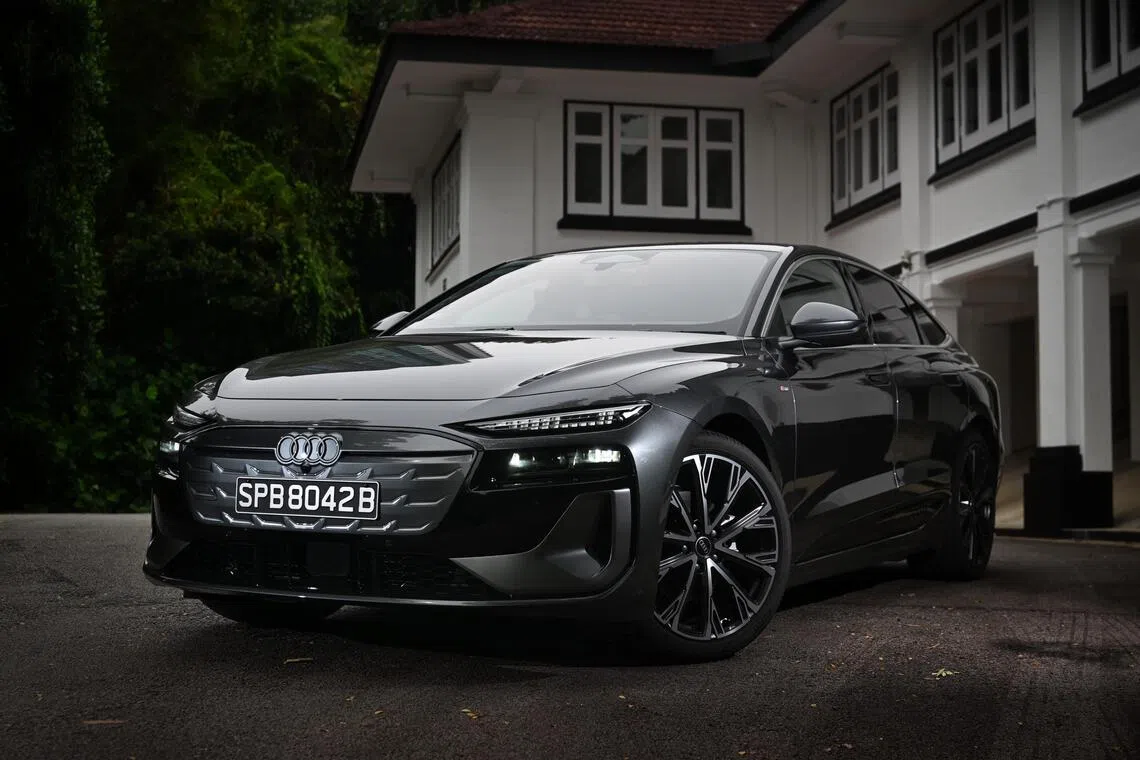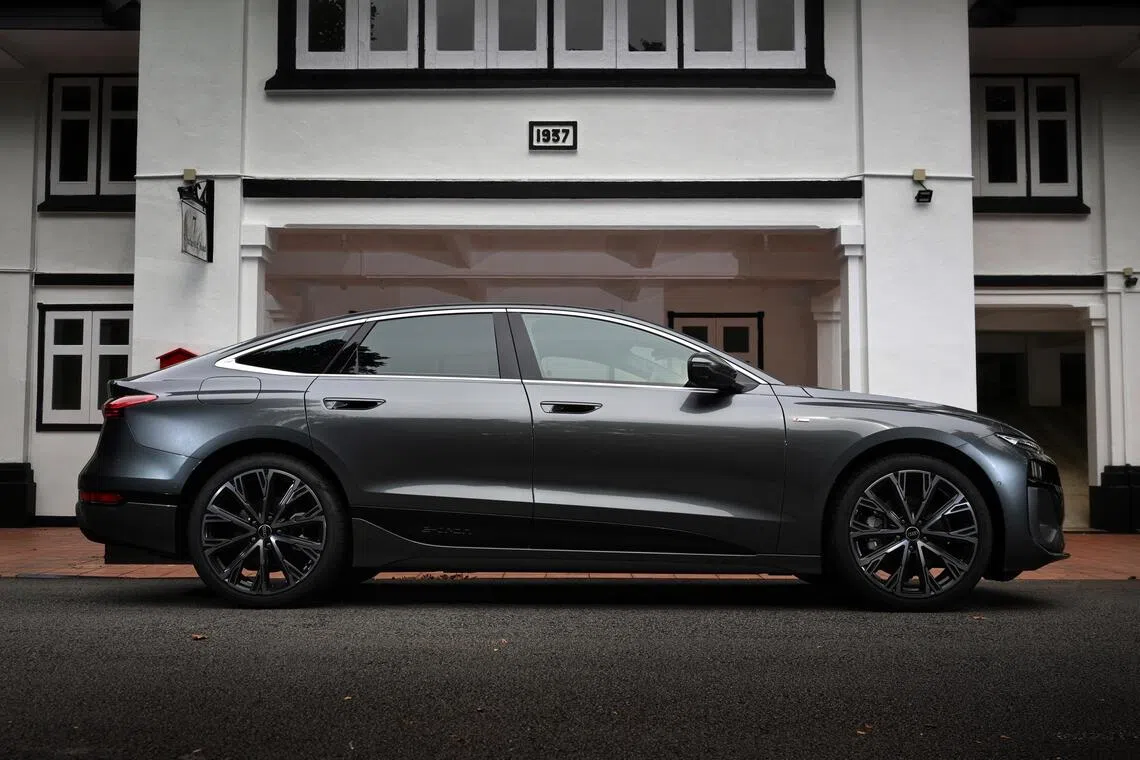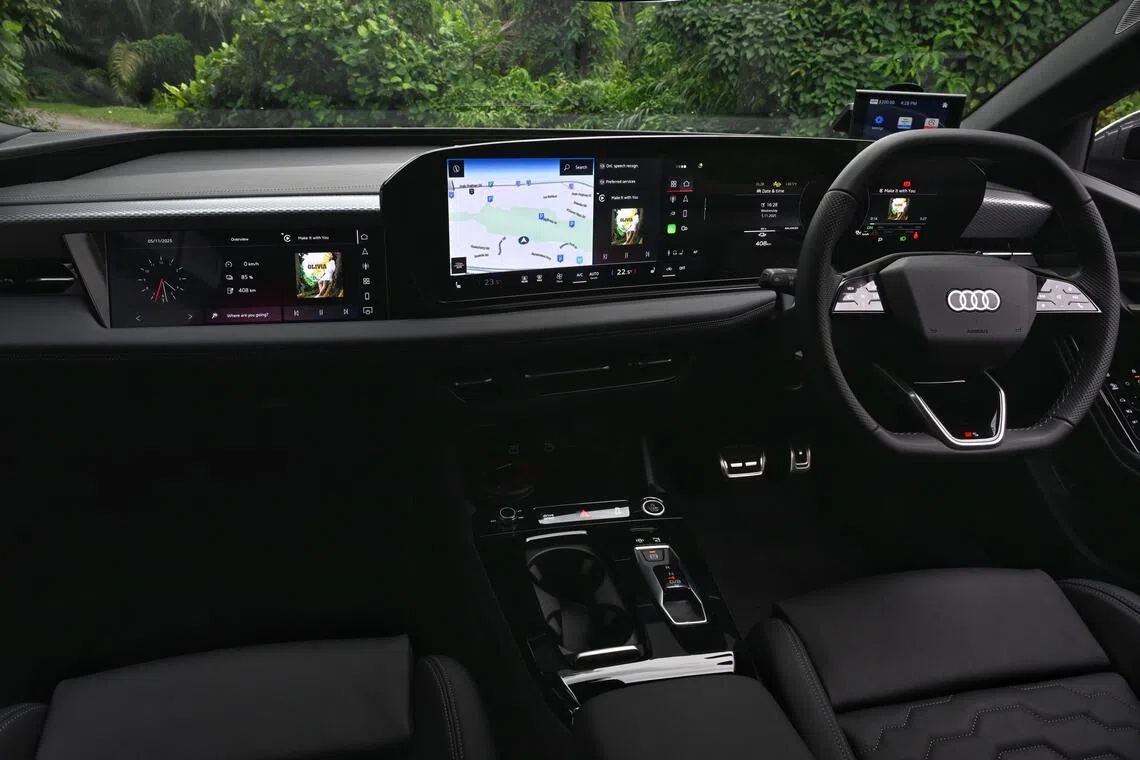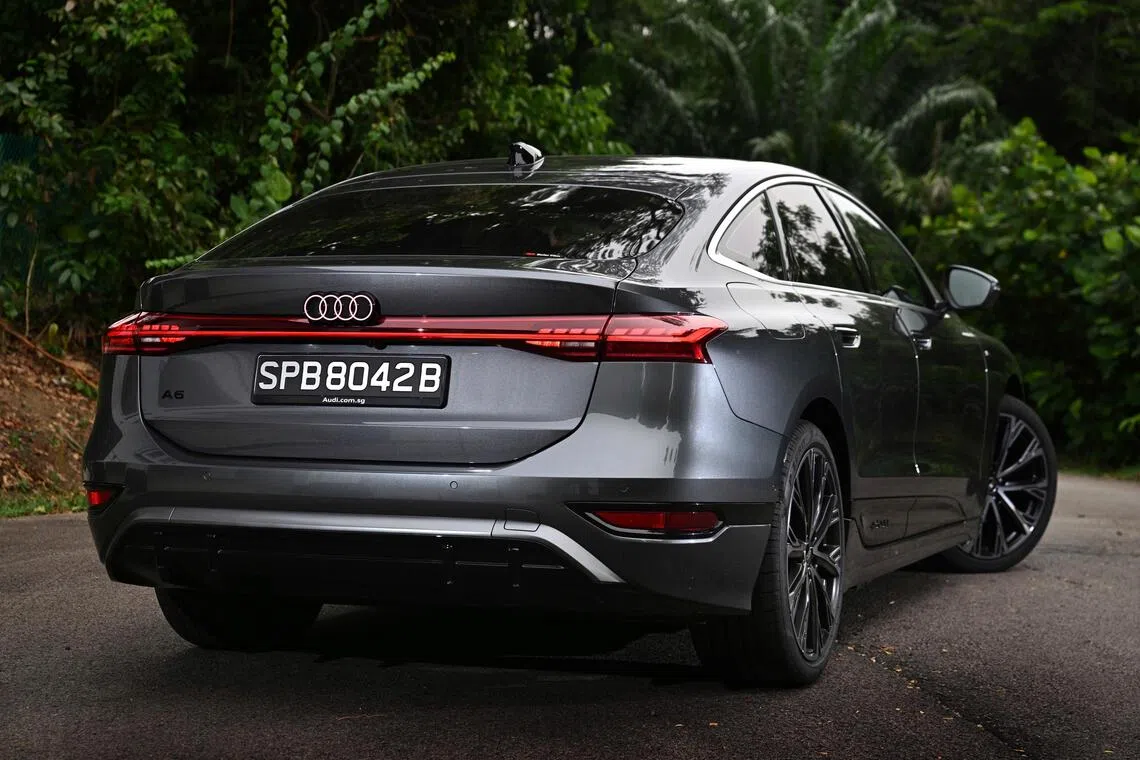Car review: Audi’s first-ever electric A6 is a do-it-all
Sign up now: Get ST's newsletters delivered to your inbox

The Audi A6 Sportback e-tron looks more aggressive than past generations of engine-powered A6s.
ST PHOTO: CHONG JUN LIANG
Follow topic:
SINGAPORE – Being not of the Generation Alpha age or a millennial, I don’t know the exact meaning of the slang term “6-7”,
To a certain extent, the term also describes the electric Audi A6 Sportback, which seems to be a combination of many things and a little tricky to pigeonhole.
Just so that everyone is on the same page with youth lingo, “6-7” is pronounced as “six seven”. And as impossible as it may seem, the term really does not have an actual definition, although Dictionary.com said that it is “meaningful to the people who use it because of the connection it fosters”.
Traditionally, the Audi A6 is fairly easy to define. This is Audi’s rival to the BMW 5-series and Mercedes-Benz E-class. It is a business saloon, favoured by executives.
With the A6 Sportback e-tron, things become less straightforward. At 4,928mm long, the electric car is shorter overall than the BMW i5 by 132mm.
This is the first electric A6. Given that the very impressive e-tron GT – The Straits Times’ 2021 Car of the Year – has not been available in Singapore for some time now, the A6 Sportback is Audi’s only electric model here that is not a sport utility vehicle.
One would assume that the electric A6 would basically be a variation of the petrol-powered model, which was launched at the same event in Singapore in November. But that is not the case because the two versions of the A6 are built on different underpinnings. They also look quite different.
While the petrol-powered A6 has a conventional three-box design, which is the class norm, the electric model breaks tradition to have a liftback body format.
The electric Audi A6 looks aggressive, marking a change from the classier, more understated approach of previous A6 generations.
The car glares angrily at the road ahead with its scowling LED daytime running lights. The main beam and other lighting functions are housed in a separate cluster on either side of the lower bumper, where you would normally expect to find the intake vents of an engine-powered car.
The brand’s four-ring logo at the back is illuminated in red at night.
The bulging wheel fenders add visual muscles to a profile that has hints of the Tesla Model 3.
Audi says the A6 Sportback is its “slipperiest” production model yet, although the record drag coefficient of 0.21 refers to a slightly different version of the car from the one offered in Singapore.

The A6 Sportback e-tron has a slippery aerodynamic profile.
ST PHOTO: CHONG JUN LIANG
Audi has form when it comes to making streamlined designs. In the 1980s, its 100 saloon, which was the equivalent of the A6 back then, held the world record for having the lowest drag coefficient for a production car with a score of 0.3.
Having a gently raked elongated hatch serves a practical purpose. It is a lot easier to load in bulky objects with such a large opening.
With the rear seats in place, the luggage compartment has 502 litres of capacity, which is slightly more than the electric BMW 5-series’ 490 litres – the equivalent of 16 more bottles of wine. Curiously, the Audi’s usefully square boot has a floor that slopes upwards towards the rear bench, instead of being completely flat.
The capacity can be expanded to 1,330 litres by folding the rear seats. In contrast, the estate version of the BMW i5, which is a bigger car, maxes out at 1,700 litres with the rear bench folded.
The interior continues Audi’s tradition of good ergonomics and the use of nice materials.
The way the rear windscreen slopes limits how much the driver can see in the rear-view mirror. But the crisp video feed from the all-round cameras does a lot to take away the guesswork during parking.
The infotainment touchscreen and driver’s instruments are housed on a curved panel. An additional touchscreen display set ahead of the front passenger seat can be used for functions like navigation and watching YouTube videos.

The digital screens in the Audi A6 Sportback e-tron are crisp and responsive.
ST PHOTO: CHONG JUN LIANG
From the driver’s seat, the screen will appear to be dark when the car is on the move, while the passenger can continue watching a movie.
Just as well judged is the Audi’s electric door release feature. It looks like a conventional lever, but takes only a very slight tug to unlatch the door electrically. Pulling it further engages the mechanical back-up system. This is a more intuitive and safer solution than having a system of unmarked buttons and hidden mechanical override levers, as is the case in many Chinese electric cars.
Another good ergonomic feature in the Audi is the panel of buttons at the driver’s door. They control the lights, mirrors and child-lock settings, so there is no need to dive into the touchscreen display menu.
The slightly squarish steering wheel feels more natural to use than it looks, although it partially blocks the view of the digital display, depending on the driving position. However, the touch-sensitive controls on the spokes are probably overly responsive. A light, accidental brush of the hand is enough to switch radio stations.
The cabin floor is higher than that of typical saloon cars, so headroom is sufficient rather than generous. Lankier teenagers seated at the back will likely have to slouch slightly.
While combustion-engine A6s have always been either front- or four-wheel-drive cars, the e-tron is a rear-wheel-drive car. The drive is refined and composed, rather than being particularly dynamic as its aggressive styling suggests.

The wheel fenders are flared out, adding visual muscle.
ST PHOTO: CHONG JUN LIANG
With 210kW on tap and 240kW in launch control mode, the car is certainly capable of very spirited getaways from the stop line.
Those who do not like the synthesised “engine noise” can deactivate the function through the driving mode settings.
The car is as quiet as only an electric vehicle can be. Without any music playing, it is possible to hear a slight hissing sound in the test car’s cabin. When asked, Audi Singapore’s expert says it is likely to do with the installation of the on-board unit for the Electronic Road Pricing (ERP) system, which is being looked into, and not the onset of tinnitus.
The car has an adaptive automatic energy recuperation mode, which will apply a bit of braking pressure through the electric motor when sensors detect that the vehicle ahead is slowing down or when the accelerator is eased.
The system does it very subtly, which is good. The idea is to increase driving range by recapturing energy when the car is slowing down.

With the rear seats in place, the luggage compartment has 502 litres of capacity, which is slightly more than the electric BMW 5-series’ 490 litres.
ST PHOTO: CHONG JUN LIANG
Energy recovery also happens when the driver uses the brake pedal or tugs the paddles behind the steering wheel.
The test drive covers just under 260km over 2½ days, with a roughly equal mix of expressway and city driving, recording an average energy consumption rate of 16.8kWh/100km.
At the end of the drive, the car has slightly more than 200km worth of charge remaining in the battery. So, realistically, the A6 should be good for more than 450km of driving before it needs to be plugged in.
Besides the edition 1 trim tested, the A6 Sportback e-tron also comes in the advanced trim, which is already quite well equipped but costs $20,000 less. This is probably the version to look at because the price puts the electric A6 closer to the BMW i4 – which is one rung below the Audi – than the i5, which is the rightful rival.
Audi A6 Sportback edition 1 e-tron
Price: $390,999 with certificate of entitlement (COE) before applicable discounts
Motor: Rear-mounted permanent magnet synchronous with 75.8kWh battery
Transmission: Single-speed automatic
Power: 210kW
Torque: 435Nm
0-100kmh: Six seconds
Top speed: 210kmh
Power consumption: 15.4kWh/100km
Charging capacity: 11kW AC; 225kW DC
Agent: Audi Singapore
Rating: ★★★☆☆
Comparable considerations
BMW i5 eDrive40 (from $412,888 with COE)
The BMW i5 is physically larger than the Audi A6 Sportback e-tron. The digital user interface is comparable with the Audi’s, but BMW has an edge in terms of connectivity, especially in the capability of the smartphone app. The car’s larger footprint is felt on the road, where there will be a higher chance of the i5 sticking out of a parking space or clipping a kerb than the nimbler A6. If it must be a BMW, then the i4 Gran Coupe eDrive35 ($347,888 with COE) is also worth a look. It is a sharper drive than the A6 and has a lower asking price, but it is an older model.
Mercedes-Benz EQE300 Electric Art ($403,888 with COE)
The Mercedes-Benz EQE’s egg-shaped silhouette is an acquired taste as it looks nothing like the typical executive express. In EQE300 form, the car has less power than the Audi at 195kW and it takes nearly a second longer to get to 100kmh from rest. Mercedes-Benz has said the model’s successor will be more closely based on the E-class as part of the company’s revision of its electric car strategy.


